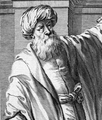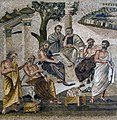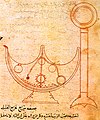Portal:History of science
The History of Science Portal
The history of science covers the development of science from ancient times to the present. It encompasses all three major branches of science: natural, social, and formal. Protoscience, early sciences, and natural philosophies such as alchemy and astrology during the Bronze Age, Iron Age, classical antiquity, and the Middle Ages declined during the early modern period after the establishment of formal disciplines of science in the Age of Enlightenment.
Science's earliest roots can be traced to Ancient Egypt and Mesopotamia around 3000 to 1200 BCE. These civilizations' contributions to mathematics, astronomy, and medicine influenced later Greek natural philosophy of classical antiquity, wherein formal attempts were made to provide explanations of events in the physical world based on natural causes. After the fall of the Western Roman Empire, knowledge of Greek conceptions of the world deteriorated in Latin-speaking Western Europe during the early centuries (400 to 1000 CE) of the Middle Ages, but continued to thrive in the Greek-speaking Byzantine Empire. Aided by translations of Greek texts, the Hellenistic worldview was preserved and absorbed into the Arabic-speaking Muslim world during the Islamic Golden Age. The recovery and assimilation of Greek works and Islamic inquiries into Western Europe from the 10th to 13th century revived the learning of natural philosophy in the West. Traditions of early science were also developed in ancient India and separately in ancient China, the Chinese model having influenced Vietnam, Korea and Japan before Western exploration. Among the Pre-Columbian peoples of Mesoamerica, the Zapotec civilization established their first known traditions of astronomy and mathematics for producing calendars, followed by other civilizations such as the Maya.
Natural philosophy was transformed during the Scientific Revolution in 16th- to 17th-century Europe, as new ideas and discoveries departed from previous Greek conceptions and traditions. The New Science that emerged was more mechanistic in its worldview, more integrated with mathematics, and more reliable and open as its knowledge was based on a newly defined scientific method. More "revolutions" in subsequent centuries soon followed. The chemical revolution of the 18th century, for instance, introduced new quantitative methods and measurements for chemistry. In the 19th century, new perspectives regarding the conservation of energy, age of Earth, and evolution came into focus. And in the 20th century, new discoveries in genetics and physics laid the foundations for new sub disciplines such as molecular biology and particle physics. Moreover, industrial and military concerns as well as the increasing complexity of new research endeavors ushered in the era of "big science," particularly after World War II. (Full article...)
Selected article -

The Strategic Defense Initiative (SDI), derisively nicknamed the Star Wars program, was a proposed missile defense system intended to protect the United States from attack by ballistic nuclear missiles. The program was announced in 1983, by President Ronald Reagan. Reagan called for a system that would render nuclear weapons obsolete, and to end the doctrine of mutual assured destruction (MAD), which he described as a "suicide pact". Elements of the program reemerged in 2019 under the Space Development Agency (SDA).
The Strategic Defense Initiative Organization (SDIO) was set up in 1984 within the US Department of Defense to oversee development. Advanced weapon concepts, including lasers, particle-beam weapons, and ground and space-based missile systems were studied, along with sensor, command and control, and computer systems needed to control a system consisting of hundreds of combat centers and satellites spanning the globe. The US held a significant advantage in advanced missile defense systems through decades of extensive research and testing. Several concepts, technologies and insights obtained were transferred to subsequent programs. Under SDIO's Innovative Sciences and Technology Office, investment was made in basic research at national laboratories, universities, and in industry. These programs have continued to be key sources of funding for research scientists in particle physics, supercomputing/computation, advanced materials, and other critical science and engineering disciplines. (Full article...)
Selected image

An anthropometric device (side view) by Major A.J.N. Tremearne designed "for measuring the living head" for "the use of anthropologists", invented in 1913 with later additions made at the suggestion of A. Keith and Karl Pearson.
Did you know
...that the history of biochemistry spans approximately 400 years, but the word "biochemistry" in the modern sense was first proposed only in 1903, by German chemist Carl Neuberg?
...that the Great Comet of 1577 was viewed by people all over Europe, including famous Danish astronomer Tycho Brahe and the six year old Johannes Kepler?
...that the Society for Social Studies of Science (often abbreviated as 4S) is, as its website claims, "the oldest and largest scholarly association devoted to understanding science and technology"?
Selected Biography -
John Harrison (3 April [O.S. 24 March] 1693 – 24 March 1776) was an English carpenter and clockmaker who invented the marine chronometer, a long-sought-after device for solving the problem of how to calculate longitude while at sea.
Harrison's solution revolutionized navigation and greatly increased the safety of long-distance sea travel. The problem he solved had been considered so important following the Scilly naval disaster of 1707 that the British Parliament was offering financial rewards of up to £20,000 (equivalent to £3.97 million in 2025) under the 1714 Longitude Act, though Harrison never received the full reward due to political rivalries. He presented his first design in 1730, and worked over many years on improved designs, making several advances in time-keeping technology, finally turning to what were called sea watches. Harrison gained support from the Longitude Board in building and testing his designs. Towards the end of his life, he received recognition and a reward from Parliament. He came 39th in the BBC's 2002 public poll of the 100 Greatest Britons. (Full article...)
Selected anniversaries
- 1493 - Christopher Columbus leaves the New World, ending his first journey
- 1643 - Birth of Sir Isaac Newton, English mathematician and natural philosopher (d. 1727)
- 1752 - Death of Gabriel Cramer, Swiss mathematician (b. 1704)
- 1761 - Death of Stephen Hales, English physiologist (b. 1677)
- 1813 - Birth of Isaac Pitman, English inventor (Pitman shorthand) (d. 1897)
- 1882 - Death of John William Draper, English scientist, photographer (b. 1811)
- 1940 - Birth of Brian Josephson, Welsh physicist, Nobel laureate
- 1945 - Birth of Richard R. Schrock, American chemist, Nobel laureate
- 1961 - Death of Erwin Schrödinger, Austrian physicist, Nobel laureate (b. 1887)
- 1990 - Death of Harold Edgerton, American electrical engineer (b. 1903)
- 2005 - Death of Frank Harary, American mathematician (b. 1921)
Related portals
Topics
General images
Subcategories
Things you can do
Help out by participating in the History of Science Wikiproject (which also coordinates the histories of medicine, technology and philosophy of science) or join the discussion.
Associated Wikimedia
The following Wikimedia Foundation sister projects provide more on this subject:
-
Commons
Free media repository -
Wikibooks
Free textbooks and manuals -
Wikidata
Free knowledge base -
Wikinews
Free-content news -
Wikiquote
Collection of quotations -
Wikisource
Free-content library -
Wikiversity
Free learning tools -
Wiktionary
Dictionary and thesaurus









































































